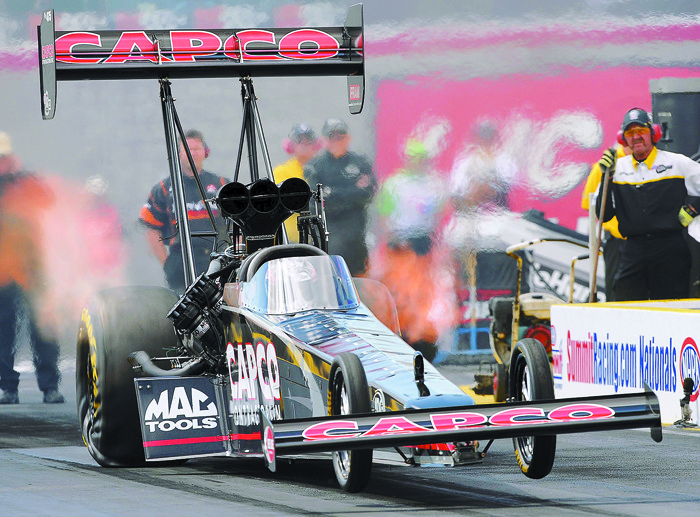Like many professional drivers in the National Hot Rod Association, Steve Torrence, pilot of the Capco Top Fuel dragster, grew up at the drag strip.
Unlike other drivers, however, he’s known tragedy, which propelled his career forward and brought it to a halt.
An accident that killed a driver led to an incredible run for Torrence in 2005 after cancer had sidelined him in 2000.
“That was probably the biggest victory of all (beating cancer),” Torrence said. “That was way bigger than any Wally I’ve ever won. It’s been a life changing experience.”
(The Wally is a trophy awarded to winners of an NHRA national event.)
Yet having overcome that and the other obstacles it takes to assemble a race team, Torrence has come screaming out of the gate this season. He’s already gone to four finals, taken two event wins and comes into the 25th annual O’Reilly Auto Parts Northwest Nationals at Pacific Raceways in fourth place in the Top Fuel class.
“We started 2012 just with the hopes of being somewhat competitive,” Torrence said. “I don’t think we could’ve plotted it out any better than that.”
All this after racing just three full seasons from his 2006 start in Top Fuel.
His father, Billy, began racing sportsman when Torrence was 6 years old. Before the younger Torrence got behind the wheel of a super comp car at the age of 15, he had already raced motorcycles, although he bypassed the more typical entry into drag racing, the Junior Dragster series.
In 2004, Torrence went to Frank Hawley’s driving school to earn his alcohol dragster license,
But in April 2005 tragedy hit.
“Shelly Howard was killed in an accident,” Torrence said. “I was called by her husband and crew chief to see if I wanted her seat. I went in and fit in well with the team. We started racing in June, and I had never driven anything other than what I had gotten my license in.”
Torrence drove in 13 races in the alcohol dragster previously driven by Howard. He made it to 11 finals and won nine of them en route to the NHRA Top Alcohol crown.
“If you don’t believe in God, that season would at least make you believe in miracles,” Torrence said.
In 2006 Torrence got the chance to move into the pro ranks when he drove Dexter Tuttle’s Top Fuel dragster.
“It was a pretty big transition, but not really as great as going from sportsman to alcohol,” Torrence said. “The quickest and fastest I had ever run in an alcohol car was when I went 5.20 at 227 mph. It’s a pretty drastic jump, to say the least. When these things take off, you thought you were going pretty fast in an alcohol car, it keeps going as hard as you left, if not harder.”
Not a surprise given that a Top Fuel dragster can top out at faster than 300 mph by the time it reaches the finish line 1,000 feet down track while generating close to 8,000 horsepower. And the long, skinny cars can — when the conditions are right — make it down the drag strip in less than four seconds, thanks to the nitromethane-gasoline fuel mixture used in them and the Funny Cars.
What he’s accomplished this season is amazing, too, given the fact Torrence put his team together in 3 1/2 months.
“We raced the last three races of 2006,” Torrence said. “That’s when the demise of Torco Fuels began. I didn’t race in 2007, sporadically in 2008. I raced the full season in 2010. Capco was still on the car, Capco is our family business. Last year we started the season and about halfway through we decided to start our own family Top Fuel team. We ran the last few races of last year just to get our feet wet.”
With crew chief Richard Hogan on board, Torrence has put together quite a run so far, and he hopes to keep it going.
“It maintains a level of professionalism and the expectations of what we’re trying to achieve over here,” he said. “We haven’t really changed our goals, we’ve just reached them a lot sooner than we expected. Now we’re at a point where we try to maintain consistency and solidify ourselves as a championship contending team.”
Heading into the Northwest Nationals, the final stop on the three-race Western Swing, Torrence said he is confident that Hogan can tune the car for whatever the weather conditions are, be they 100-degree temperatures or 75 and cloudy.
“I feel like right now we’re in a pretty safe position — knock on wood — and unless something catastrophic happens, we’ll still be in fourth (after the swing),” Torrence said. “We have some opportunities to gain some ground and move into third. We’re capable of running in these conditions as well as 100-degree conditions. As for me, I just keep doing my job, practice on the tree and continue to be the machine and flawless.”


